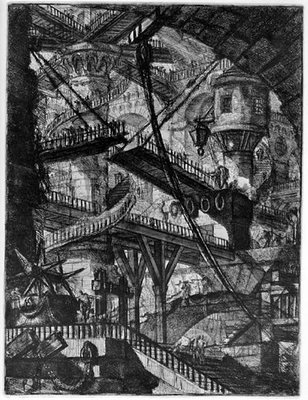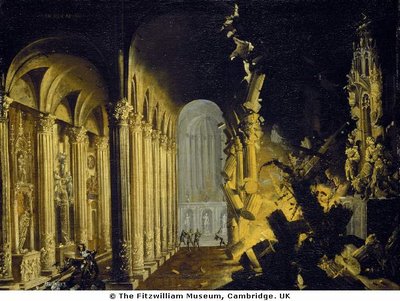Dark Art
Lovers of outré and darkly baroque art, Goths of every stripe and anyone who’s read and enjoyed Peake’s Titus Groan -- there’s an exhibition on in Stockholm that you don’t want to miss.
As his farewell show, retiring museum director Hans Henrik Brummer has put together one hell of a triple feature at the Waldemarsudde art museum. He calls it "Unsafe Spaces".

The show starts off with a huge room devoted to the sixteen numbers of 18th century Italian printmaker Giovanni Battista Piranesi's Carceri d'Invenzione ("Fantasy Prisons", or why not, "Fantasy Dungeons"). I'd only seen a few of them before and never at the original large scale. Incredible stuff; kaleidoscopic subterranean vistas peopled by faceless tiny figures scaling endless stairs. Coleridge loved them. Doré copied them. Escher reimagined them as Moebius strips.

F.D. Nomé. King Asa of Judah destroying the Idols. Fitzwilliam Museum, Cambridge. Not in the Stockholm exhibition.
The next room introduced me to 17th century painter François de Nomé. He too was obsessed with fantasy architecture depicted in dramatic chiaroscuro -- but he preferred to paint it at the moment when it is tumbling down. His paintings may be named "Aeneas flees the burning Troy" or "The Martyrium of St. Catherine", but such mythological matter is only afforded a little corner of each canvas. The rest is devoted to Boschian filigree towers, collapsing arches and burning cities.

In the final two rooms, contemporary painter Ulrik Samuelsson has collected a number of his own canvases together with anonymous works of 15th and 16th century church art. And Samuelsson has taste. The most striking piece is a grotesquely gory and tortured Christ, sculpted at a superhuman scale, originally part of the triumphal crucifix in Sorunda church, Södermanland. This masterful sculpture is extremely stylized and non-naturalistic, to the point where the man's twisted body looks a bit like that of an emaciated horse. Utter madness, and still tightly controlled. Christ as pagan god or tribal idol, wild stuff.
Then there's a life-sized St. Anne from Frötuna church in Uppland, her paint and gilding largely flaked away, but still smiling beatifically. The sculptures are beautifully lit and neither is behind glass: St. Anne you can actually walk around with your nose a hair's breadth from the piece, and study the hollowed back that was never intended to be seen. It's a rare treat indeed to be able to engage so intimately with Medieval wooden sculpture.
"Unsafe Spaces" will be on until 7 January 2007. Prepare to get your mind blown.
[More blog entries about art, piranesi, fantasy, horror, Sweden; konst, piranesi, fantasy, skräck.]
As his farewell show, retiring museum director Hans Henrik Brummer has put together one hell of a triple feature at the Waldemarsudde art museum. He calls it "Unsafe Spaces".

The show starts off with a huge room devoted to the sixteen numbers of 18th century Italian printmaker Giovanni Battista Piranesi's Carceri d'Invenzione ("Fantasy Prisons", or why not, "Fantasy Dungeons"). I'd only seen a few of them before and never at the original large scale. Incredible stuff; kaleidoscopic subterranean vistas peopled by faceless tiny figures scaling endless stairs. Coleridge loved them. Doré copied them. Escher reimagined them as Moebius strips.

F.D. Nomé. King Asa of Judah destroying the Idols. Fitzwilliam Museum, Cambridge. Not in the Stockholm exhibition.
The next room introduced me to 17th century painter François de Nomé. He too was obsessed with fantasy architecture depicted in dramatic chiaroscuro -- but he preferred to paint it at the moment when it is tumbling down. His paintings may be named "Aeneas flees the burning Troy" or "The Martyrium of St. Catherine", but such mythological matter is only afforded a little corner of each canvas. The rest is devoted to Boschian filigree towers, collapsing arches and burning cities.

In the final two rooms, contemporary painter Ulrik Samuelsson has collected a number of his own canvases together with anonymous works of 15th and 16th century church art. And Samuelsson has taste. The most striking piece is a grotesquely gory and tortured Christ, sculpted at a superhuman scale, originally part of the triumphal crucifix in Sorunda church, Södermanland. This masterful sculpture is extremely stylized and non-naturalistic, to the point where the man's twisted body looks a bit like that of an emaciated horse. Utter madness, and still tightly controlled. Christ as pagan god or tribal idol, wild stuff.
Then there's a life-sized St. Anne from Frötuna church in Uppland, her paint and gilding largely flaked away, but still smiling beatifically. The sculptures are beautifully lit and neither is behind glass: St. Anne you can actually walk around with your nose a hair's breadth from the piece, and study the hollowed back that was never intended to be seen. It's a rare treat indeed to be able to engage so intimately with Medieval wooden sculpture.
"Unsafe Spaces" will be on until 7 January 2007. Prepare to get your mind blown.
[More blog entries about art, piranesi, fantasy, horror, Sweden; konst, piranesi, fantasy, skräck.]



8 Comments:
Cool crucifix. Very Baconian.
Yes indeed. Some of Samuelsson's own work in the adjacent room shows clear influences from F. Bacon.
Cool. That sounds like something to have a look at. (Right now, I'm also interested in looking at the Hans Arnold exhibition going on at Seriegalleriet.)
Incidentally, did you know that Sam J. Lundwalls novel Fängelsestaden is inspired and illustrated by these Piranesi images?
I didn't know that. Actually, I've never read any of Lundwall's books. Though I did read lots of the books he had translated and published in the 70s.
I have read much but not quite all of his books, and I think most of them are well worth the time.
Dover Publications have published a large-format edition of Le Carceri (ISBN 0-486-21540-7). I found my copy in SF-bokhandeln, but if they're out, there's still some at Amazon. (Unpaid plug :-)
wow.
how very .... ugly and beautiful... and wierd...
... too bad I can't go there... i'd steal the fugly J.C. right away...
A funny thing about the triumphal crucifix is that it was made to hang near the ceiling in the triumphal arch where the nave gives way to the chancel. So us seeing it at close hand and on a level isn't at all like how Medieval churchgoers saw it. But I think we're lucky.
Post a Comment
<< Home